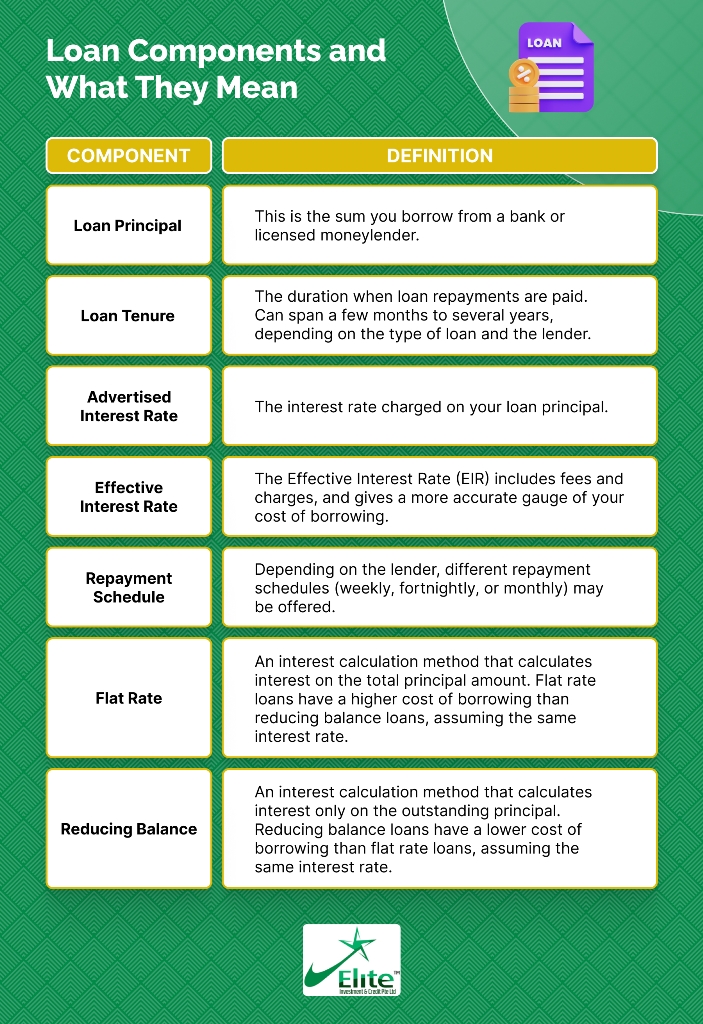When choosing a loan, an important consideration is the total interest charged on the loan. However, this can be difficult to judge just by looking at the interest rate alone. This is why it is a good idea to use a loan charge calculator to get a clearer picture of the actual cost of your loan from a legal money lender in Singapore.
What is a loan charge calculator?
A loan charge calculator automatically calculates how much total interest you have to pay on a loan, as well as the equated monthly installment (EMI) payments.
This information is useful in helping borrowers find out the actual cost of borrowing. Importantly, a loan calculator can be used to illustrate the differences between flat rate calculation and reducing balance calculation – two commonly used methods when calculating loan interest charges.
How does a loan charge calculator work?
To use a loan charge calculator, all you have to do is to input the loan principal amount, interest rate, and the loan tenure or duration.
The calculator will then show you the total interest paid, the total repayment amount (principal plus interest), and the EMI, or how much you need to pay each month.
Loan calculators are readily available online. Many banks and some licensed moneylenders offer them on their websites, to assist borrowers in evaluating a loan package.
Note that loan charge calculators are offered only as a tool, and the results do not constitute a binding loan offer. The actual cost of borrowing may differ if you are offered a different interest rate.
As such, you should always confirm the actual interest rate, total interest charges, and monthly repayment amount with the lender before accepting the loan.
READ MORE: 12-Month Loans From Direct Lenders – How Do They Work?
Benefits of using a loan charge calculator
Shows clearly the cost of borrowing
The cost of borrowing refers to how much you have to pay when taking a loan. This is made up of the interest charged on the loan, as well as any applicable fees and charges.
A loan calculator shows you the total interest payable on the loan, and by adding the loan’s fees and charges, you can see how much your cost of borrowing would be in dollar terms. This is more accurate than simply looking at the interest rate, which may not display the full picture.
Flat rate vs reducing balance
Besides the fees charged by the lender, the cost of borrowing can differ depending on whether the flat rate or reducing balance interest calculation method is used. Let’s take a closer look at how this works.
Assuming a loan of S$3,000 at 20% per annum interest, and a loan tenure of 12 months, how much total interest would you have to pay under each method?
| Flat rate method | Reducing balance method | |
| Interest (per annum) | 20% | 20% |
| Loan amount | S$3,000 | S$3,000 |
| Loan tenure | 12 months | 12 months |
| Total interest on the loan: | S$600 | S$335 |
| EMI: | S$300 | S$278 |
As you can see, a flat rate loan results in higher total interest paid. Not only that, but how much you have to pay each month (EMI) is also higher.
Why is this so? Well, in the reducing balance method, the interest is charged only on the remaining loan principal, which reduces with each monthly repayment. As a result, the interest amount each month goes down as well.
In contrast, the flat rate method calculates the interest on the entire principal, and the interest charges remain the same each month.
What is the implication of this? Well, using the flat rate method allows a lender to offer an interest rate that appears to be lower. See the next example for an explanation.
| Flat rate method | Reducing balance method | |
| Interest (per annum) | 12% | 20% |
| Loan amount | S$3,000 | S$3,000 |
| Loan tenure | 12 months | 12 months |
| Total interest on the loan: | S$360 | S$335 |
| EMI: | S$280 | S$278 |
In the second example, the interest rate for the flat rate method was reduced to 12% per annum. While this is significantly lower than the 20% interest used in the reducing balance method, the total interest and EMI is still higher.
The takeaway here is this: Interest rates aren’t the full picture when gauging the cost of borrowing a loan. Be sure to find out the calculation method used by the lender, so you can derive the true cost of borrowing.
Helps you balance between loan tenure and repayments
A question that often arises when considering a loan is whether you’d be able to cope with the loan repayments. How much do you have to pay each month? Should you choose a longer duration?
A loan charge calculator is a quick and easy way to get some answers. Choosing a longer loan tenure will lower the amount you have to pay each month. This can make your repayments easier to meet. However, a longer loan duration will also increase the total interest paid on your loan.
With a loan calculator, you can play around with different loan tenures and loan amounts to find the right balance.
Helps you determine how much you can borrow
A loan charge calculator can also help you determine how much you can safely borrow, by showing you how much the estimated monthly repayments will be.
A high loan principal may exceed your monthly budget, which means you will struggle to pay your loan, exposing you to late charges and late interest charges.
When this happens, you will need to negotiate with your lender to extend the loan tenure, which could incur added fees, and will cost you more total interest.
You can avoid this scenario by using a loan calculator to find out how much you can borrow based on your budget.
Conclusion: Use a loan charge calculator to plan your finances
Not having clarity about your finances can lead to costly mistakes, such as borrowing too much and exceeding your capacity to repay the loan.
Hence, it is advisable to use a loan charge calculator to gain a clear idea of how much you can borrow, the monthly repayments needed, and the loan tenure you should choose.
Elite Investment & Credit offers instant loans with low-interest rates and flexible repayment schedules. Contact us today to find the best loan for your needs and preferences.
About the Author
Bolstered by 14 years of elite money lending knowledge, you can count on Elite Investment & Credit to proffer personalised loan guidance to borrowers new and old alike without prejudice.


